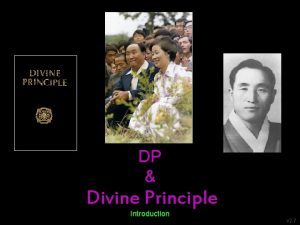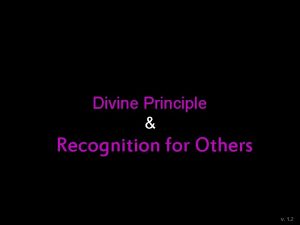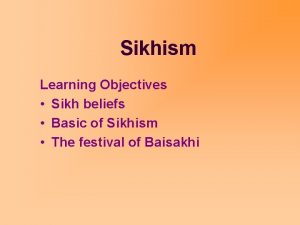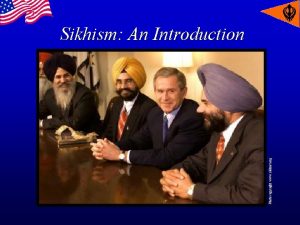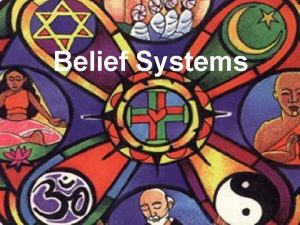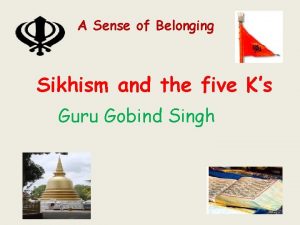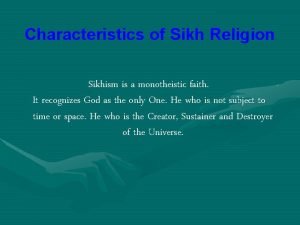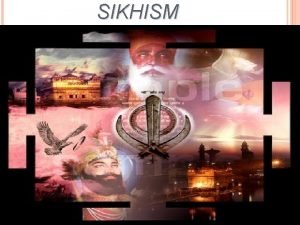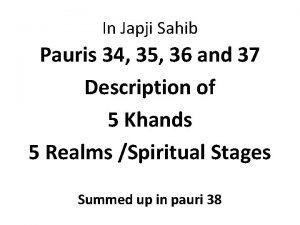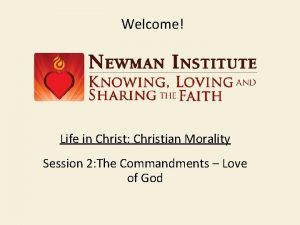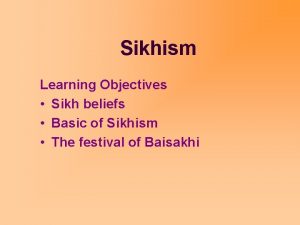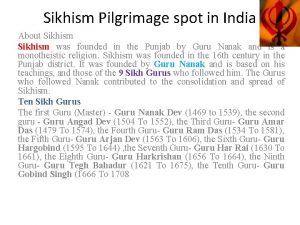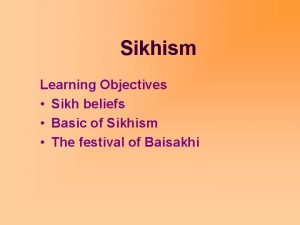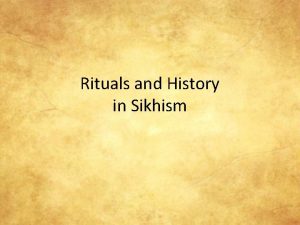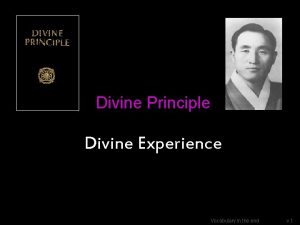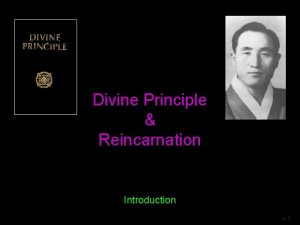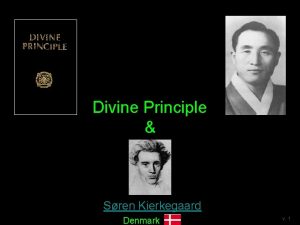Divine Principle Sikhism Introduction v 2 2 Short

































- Slides: 33

Divine Principle & Sikhism Introduction v. 2. 2

Short Vocabulary: AGS =Absolute Good Spirits CSG = Cheon Seong Gyeong, Holy Textbook CIG = Cheon Il Guk, Two persons become one, Ko. H CP = Cheong Pyeong, Spir. training ground Korea DP = Divine Principle, v 1973 EDP = Divine Principle, v 1996 ODP = Original Divine Principle, 2008 Ko. H = Kingdom of Heaven LSA = Lord of Second Advent OT = Old Testament NT = New Testament CT = Completed Testament TF = True Father, SMM = Sun Myung Moon, SMM TM = True Mother, Hak Ja Han Moon UC = Unification Church See also extended Vocabulary: http: //www. slideshare. net/bdp 003/vocabulary-uc

The Basic Beliefs of Sikhism • The people who practice Sikhism, or Sikhs, believe in One God, and the brotherhood and equality of all men and women. • The place of worship of Sikhism is called the Gurdwara (Goord-vhar-ah). • The holy book of Sikhism is the Guru Granth Sahib Ji.

The Basic Beliefs of Sikhism • There are 11 Gurus that the teachings of Sikhism are based on. (Guru means teacher and Sikh means learner. ) • Sikhs believe that God can be found within one’s own being, rather than through places of worship. The path to God is through earning an honest living, sharing with the needy and contributing to society, and living a healthy, active family life.

Origins of Sikhism • Founded by Guru Nanak, the first Guru, in the 15 th century. • Originated, in part, as a response to the Muslim forcible conversion and oppression of the Hindus during the invasion of the Mughal Empire in India.

Origins of Sikhism • Began as a “saintly” movement by Guru Nanak to find unity and devotion to God, and promote peace and brotherhood of Hindus and Muslims. Over the next 200 years and lives of the next 9 Gurus, it became a religion of the “saint-soldier, ” where Sikhs had a unique appearance and identity to serve as protectors of the weak and seekers of truth and justice.

Origins of Sikhism

Symbols of Sikhism

Ek Onkar – One God • Ek Onkar literally means One God or God is One • As one of the core the symbol is the of Sikhism. beliefs of Sikhism, Ek Onkar emblem The symbol for Ek Onkar The Sikh religion is profoundly based on the belief in and the connection to the one God.

The Khanda • The central double-edged sword symbolizes belief in one God. • The circle represents God without beginning or end. • The two swords, called Miri and Piri, symbolize the spiritual aspirations of an individual and the duty of an individual to society.

The Golden Temple • Although Sikhs believe God and that your connection with God is made from within yourself, this does not prevent them from building shrines to mark important places and events in Sikh history. (i. e. The Golden Temple) • Harminder means “the temple of the Lord”, and while it is the name of a number of Sikh shrines, it is supremely the name of the Central shrine for all Sikhs at Amritsar in Punjab. • The Temple itself houses the real and original Guru Granth Sahib: the holy book of Sikhism and one of the 11 Gurus.

The Golden Temple

The Gurdwara • Gurdwara - the place where Sikhs may come to pray • Gurdwara literally means Guru’s Door, and because guru means teacher, the name implies this is a place to learn. • Each Gurdwara has a Guru Granth Sahib Ji, or the holy book. • Each Gurdwara has 4 doors, facing North, South, East, and West. This is symbolic of the Sikh philosophy that our temple is open to all.


Summary of Sikhism It is a young religion which emphasizes: • the belief in and devotion to One God • the equality and brotherhood of man • duty to society and family in everyday life

Harmindar Sahib circa 1870

In October, 1538 Nanak was about to die. His Muslim converts wanted to bury him and his Hindu converts wished to cremate him after death. To settle the argument Nanak told each group to place flowers on either side of him and the group whose flowers were still fresh in the morning could have his body. He then drew the sheet over his head and became still. When the sheet was removed the next morning both bouquets of flowers were in bloom but the body of Nanak was gone. Thus, according to this legend, even in death the peaceful and loving Nanak sought to bring harmony between Muslims and Hindus. /end of history part

From World Scriptures • Moral Law The way to salvation lies in following the divine laws and revealed teachings--e. g. , the Tao (Taoism), the Torah (Judaism), the Reading (Islam), the eternal Dharma (Hinduism and Sikhism), the Dhamma revealed by the Buddha, or the Word revealed in the Gospel (Christianity).

From World Scriptures These laws are liberating. They define the Way through which a person sanctifies his life, according to Judaism. They lay out the road to heaven, according to Hinduism and Sikhism, or to Nirvana, according to Buddhism. They are the keys to happiness and success in life, as depicted through the parables of the tree and the rock from the scriptures of Christianity and Islam. Heaven is not attained without good deeds. Liberation comes from living the holy Word. Sikhism. Adi Granth, Sri Raga, Ashtpadi 14. 8, M. 1, p. 62

From World Scriptures II • Creator He is the Sole Supreme Being; of eternal manifestation; Creator, Immanent Reality; Without Fear, Without Rancor; Timeless Form; Unincarnate; Self-existent; Realized by the grace of the Holy Preceptor. Japuji p. 1, The Mul Mantra (Sikhism) life.

From World Scriptures II • The Fall Five are the robbers lodged in this body— Lust, wrath, avarice, attachment, and egoism. Adi Granth, Sorath, M. 3, p. 600 (Sikhism)

From World Scriptures II • The path to God is through earning an honest living, sharing with the needy and contributing to society, and living a healthy, active family life. Source: www. unification. net/ws/ www. eurotongil. org/swedish/english/World_Scripture_II_Text. pdf

Unificationism Modern Peace King Rev. Dr. Sun Myung Moon 19202012

Unificationism Read more about his works for Peace: Peacemakers who have provided leadership towards the realization of this cause have been respected and appreciated. Dr. Moon is one of the most respected figures of our time who has played a magnificent role and made a remarkable contribution in the movement towards the realization of universal peace.

Unificationism He focuses on promoting and strengthening family values as the basis of a peaceful society and world. His emphasis on true love and actions of kindness even to the enemy has borne fruit and helped eliminate violence and hatred. Thus, the principles that Dr. Moon advocates are paving the way for dialogue and understanding among the religions and races of the world. Source: http: //archive. upf. org/publications/peacekingonline/6. htm

Ambassador K. V. Rajan Ambassador from India to Nepal (1995 -2000) As a professional diplomat, I recall my curiosity several decades ago about the controversy generated about Father Moon in the United States. I was then serving in Washington, D. C. , and was invited by a group of fellow diplomats from Asian countries for a series of informal brainstorming sessions with academics, media persons and young professionals on how, utilizing Father Moons initiatives, civil society could strengthen official efforts to create a more peaceful world order.

Ambassador K. V. Rajan Ambassador from India to Nepal (1995 -2000) Gandhis emphasis on peacebuilding through concentric circles of human commitment�the individual at the center surrounded respectively by the family, community, nation and the world had much to do with Indias success in liberating itself from the colonial yoke through non-violent means, and it remains at the root of Indias aspiration for becoming a major world power dedicated to peace. This finds an echo for Indians in Father Moons emphasis on each individual being prepared to serve, sacrifice, and if necessary, suffer in the cause of peace.

Ambassador K. V. Rajan Ambassador from India to Nepal (1995 -2000) The essence of Father Moons message is that unless the root causes of violence are tackled, the world will witness human tragedy on an unprecedented scale. Father Moons personal sacrifices and sufferings, his incredibly punishing daily schedule, and his perseverance in building trust where there was enmity, interdependence where there was non-communication, harmony where there was conflict, and love where there was hatred, are examples for the rest of humanity.

Ambassador K. V. Rajan Ambassador from India to Nepal (1995 -2000) The objective is a global family in which human beings of all colors, nationalities and creeds are conscious of their common destiny and mutual interdependence, in which service rather than self is the real meaning of existence at the level of individuals, families and institutions. If we start an irreversible process towards achieving that world, Father Moons sacrifices will not have been in vain. Source (link): india site: archive. upf. org/publications/peacekingonline See also Biography (Google for): As a Peace-loving Global Citizen Divine Principle Nepalese version – www. euro-tongil. org/swedish/english/PPT/DP_Nepal/

Unification News for March 2003 RYS in New Zealand by Paul Saver From Jan 4 th to Jan 10 th RYS New Zealand conducted it’s first international RYS project held in and around Rotorua, world famous for it’s thermal springs. The theme was "Building a Culture of Everlasting Peace". Forty five participants came from across New Zealand, Australia, Japan, PNG and USA representing Christianity (Protestant and Catholic), Sihkism, Buddhism, Islam, New Zealand Maori, Australian Aboriginals and Unificationism.

The work projects took place at five different sites and included restoration of grave stones at a soldiers cemetery, clean up of the foreshore of Lake Rotorua, painting, plus clearing of walking tracks. At each work project, RYS participants provided a willing voluntary workforce to assist local organizations serve the community. One such prominent local organization which RYS assisted was Habitat for Humanity which has chapters all through NZ and throughout the world.

References: Main History Source: Sarena K. Gill www. slideshare. net/kumargill/what-is-sikhism Divine Principle: www. unification. net/dp 96 Speeches by Sun Myung Moon: www. tparents. org/Lib-Moon-Talk. htm www. unification. net/ws/ www. euro-tongil. org/swedish/english/World_Scripture_II_Text. pdf archive. upf. org/publications/peacekingonline/6. htm

Remember the beauty in Gods nature is there to inspire the most Holy original inside us all! Have a great Blessed week. Prepared for 2 nd, 3 rd. . . Gen inspiration by Bengt de Paulis.
 Short short short long long long short short short
Short short short long long long short short short Divine principle 3 hour lecture
Divine principle 3 hour lecture Exposition of the divine principle
Exposition of the divine principle Divine principle powerpoint
Divine principle powerpoint Divine principle powerpoint
Divine principle powerpoint 5ks sikhism
5ks sikhism Sikhism origin
Sikhism origin Sikhism beliefs
Sikhism beliefs When was sikhism founded
When was sikhism founded Karma in sikhism
Karma in sikhism Beliefs and practices of sikhism
Beliefs and practices of sikhism Maya sikhism
Maya sikhism Sikhism place of worship
Sikhism place of worship Sikh beliefs
Sikh beliefs Sikhism mono or poly
Sikhism mono or poly Sikhism
Sikhism Characteristics of sikhism
Characteristics of sikhism Sikhism
Sikhism Universalizing religion ap human geography
Universalizing religion ap human geography Are sikhs vegetarian
Are sikhs vegetarian Japji sahib slides
Japji sahib slides Sikhism vs hinduism
Sikhism vs hinduism Sikhism beliefs
Sikhism beliefs Is sikhism universalizing or ethnic
Is sikhism universalizing or ethnic Maikling kwento kahulugan
Maikling kwento kahulugan Hh
Hh What is the story all about
What is the story all about About me biography
About me biography The divine praises prayer
The divine praises prayer Supernatural elements of the bible
Supernatural elements of the bible Divine revelation definition
Divine revelation definition The divine source
The divine source Divine alignment
Divine alignment The divine comedy summary
The divine comedy summary

